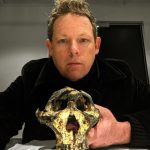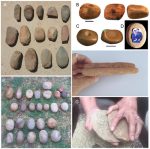The Archaeological and Anthropological Society of Victoria is a group that promotes the study of archaeology, anthropology, ethno-archaeology and ethno-history in both Australia and further abroad. Lectures, from a range of talented presenters, are held every third Thursday of the month at 6:30pm at the Kathleen Syme Library & Community Centre (251 Faraday St, Carlton), and are also accessible online via Zoom.
**To attend via Zoom, please register with this link, and you will be emailed your code.
Next Lecture: Thursday 20 November 2025
Prof. Herries’ talk will follow the society’s AGM, which begins at 6.30 pm. All are welcome, and members are especially encouraged to attend. Light refreshments will be served at the conclusion of the lecture.
When three human species met two million years ago?
Presented by Professor Andy Herries
 This talk will outline new research and excavations at the sites of Drimolen and Kromdraai in the UNESCO Cradle of Humankind Heritage site in South Africa. These caves have yielded the oldest evidence for the direct modern human ancestor, Homo erectus, and the most complete skull of a side branch in our evolutionary tree, Paranthropus robustus. From sites nearby, there are late-occurring fossils of the genus Australopithecus, a more ape-like species first described by Australian anatomist Raymond Dart in 1925, 100 years ago.
This talk will outline new research and excavations at the sites of Drimolen and Kromdraai in the UNESCO Cradle of Humankind Heritage site in South Africa. These caves have yielded the oldest evidence for the direct modern human ancestor, Homo erectus, and the most complete skull of a side branch in our evolutionary tree, Paranthropus robustus. From sites nearby, there are late-occurring fossils of the genus Australopithecus, a more ape-like species first described by Australian anatomist Raymond Dart in 1925, 100 years ago.
Biography
Andy Herries is Professor of Palaeoanthropology and director of the Australian Archaeomagnetism Laboratory at La Trobe University’s Department of Archaeology and History in Melbourne. He is also Associate Senior Research Fellow at the University of Johannesburg and Director of the Drimolen Palaeoanthropology Field School in South Africa.
Previous Lecture: 16 October 2025
First Australian inventions: grinding, pounding and Ground Stone Tools
Presented by Dr Richard Fullagar
 Madejedbebe, an excavated site in western Arnhem Land, has the earliest examples of edge-ground hatchets in the world and a continuous record of grinding and pounding implements (Ground Stone Tools) spanning 65,000 years. In other parts of northern Australia, deep gorges have ancient rock engravings and outwash streams that are bordered with thousands of Ground Stone Tools, providing evidence of grinding crushing and pounding materials for food, craft and other purposes. However, Ground Stone Tools are extremely rare in excavated sites and our understanding of this technology depends on analysis of the composition, distribution and function of undated surface collections. Australian typologies of Ground Stone Tools (with recent revisions) include about 30 classes that are described in terms of form, function, technology, use wear and residues.
Madejedbebe, an excavated site in western Arnhem Land, has the earliest examples of edge-ground hatchets in the world and a continuous record of grinding and pounding implements (Ground Stone Tools) spanning 65,000 years. In other parts of northern Australia, deep gorges have ancient rock engravings and outwash streams that are bordered with thousands of Ground Stone Tools, providing evidence of grinding crushing and pounding materials for food, craft and other purposes. However, Ground Stone Tools are extremely rare in excavated sites and our understanding of this technology depends on analysis of the composition, distribution and function of undated surface collections. Australian typologies of Ground Stone Tools (with recent revisions) include about 30 classes that are described in terms of form, function, technology, use wear and residues.
Biography
Richard Fullagar is an Australian archaeologist who has published widely on the function of stone tools from key sites spanning early modern human dispersals in eastern Asia and the Australian region. His first job was with the Victoria Archaeological Survey (1978–1982). He is currently an Adjunct Professor involved with Australian Research Council projects led by researchers at University of Western Australia (Desert to the Sea: Managing Rock Art, Country and Culture), Flinders University (Rockshelters and Rock Art in the River Murray Gorge) and La Trobe University (Lake Mungo). He is currently writing (in collaboration with Colin Pardoe and Elspeth Hayes) a comprehensive book on Australian Aboriginal Ground Stone Tools.
Notices
Post Office Boxes
We advise all members that AASV now has two mailing addresses. Membership address: PO Box 200, Benalla VIC 3672.
General Correspondence and Artefact subscription enquiries: PO Box 203, Carlton VIC 3053.
